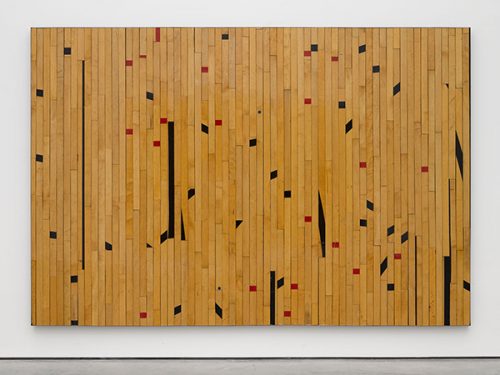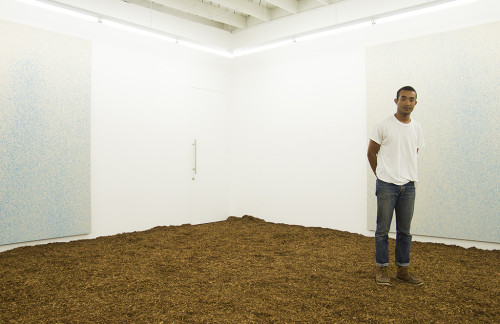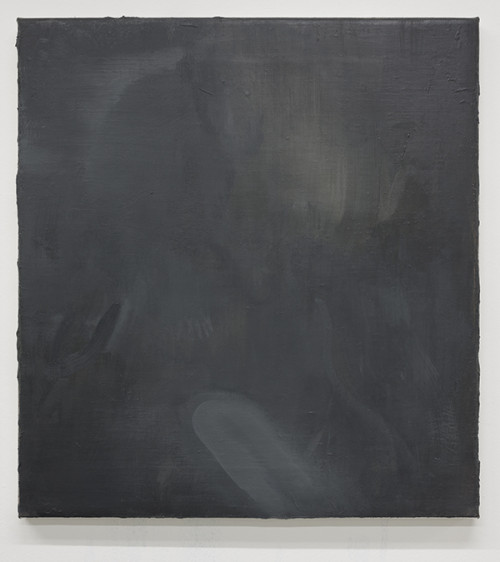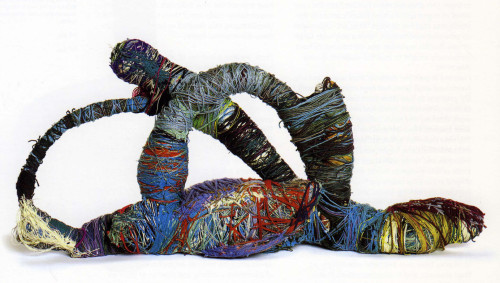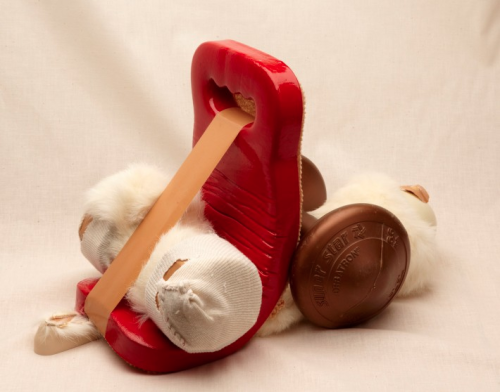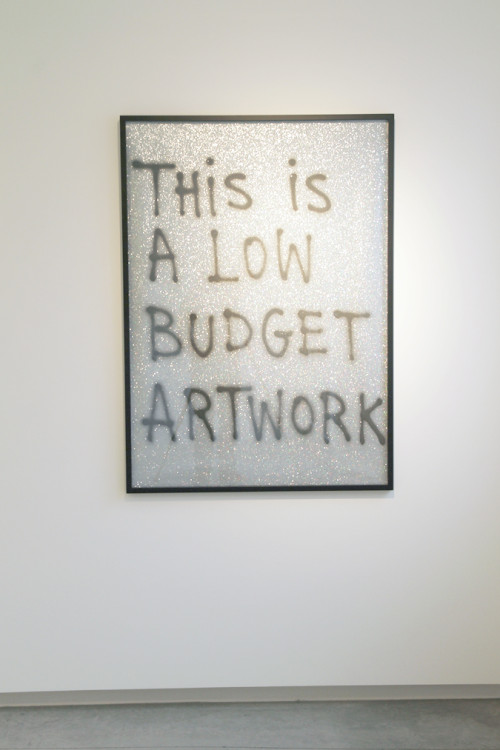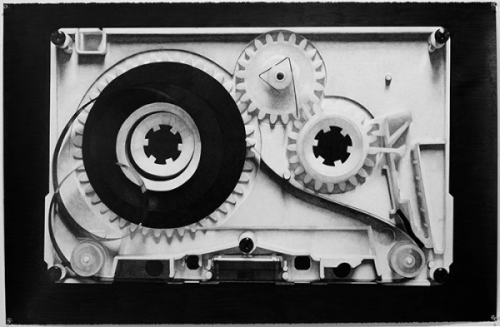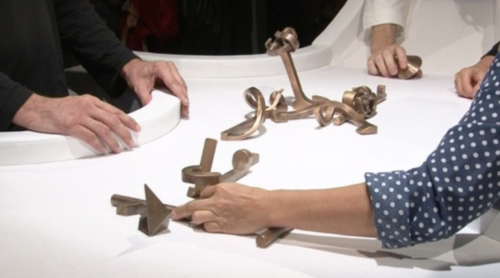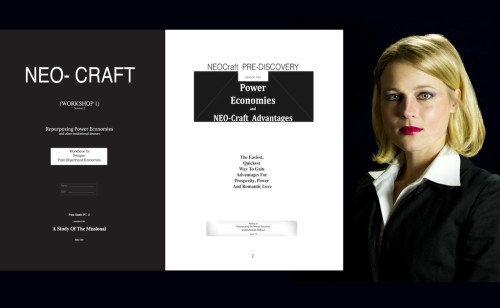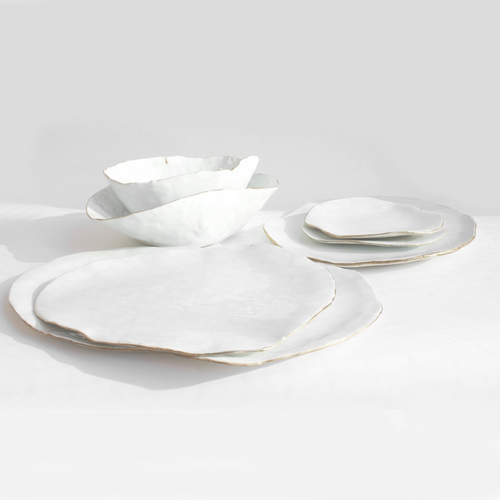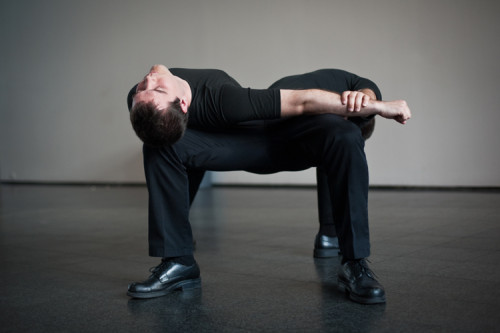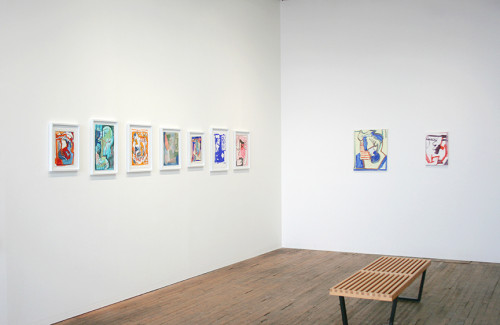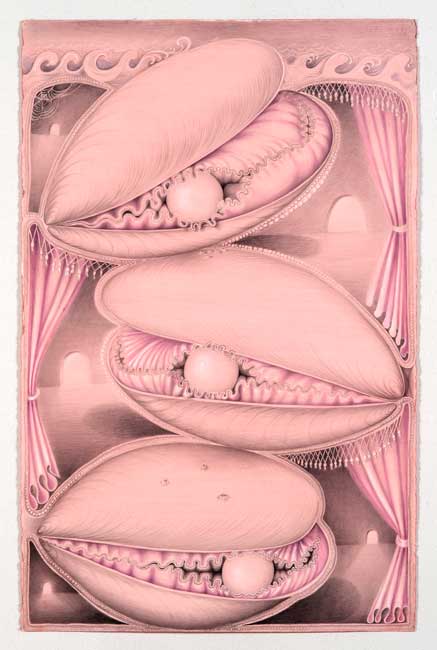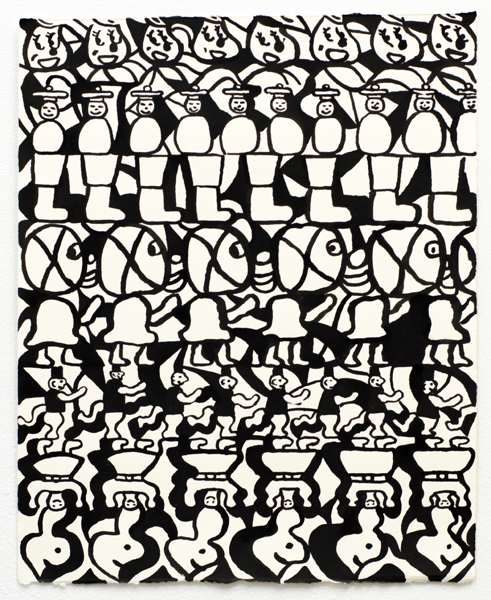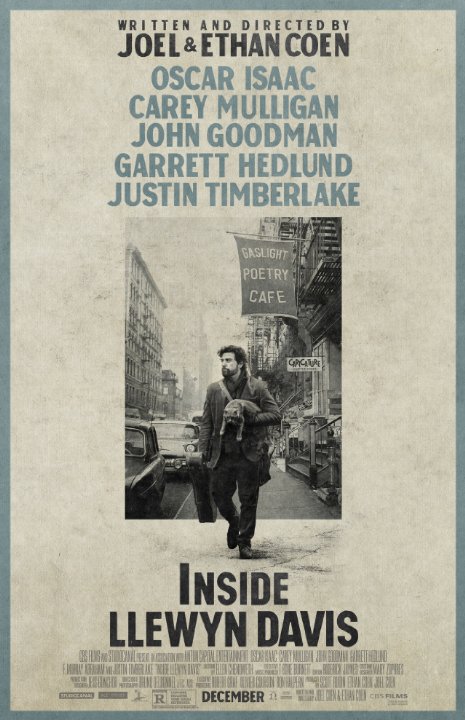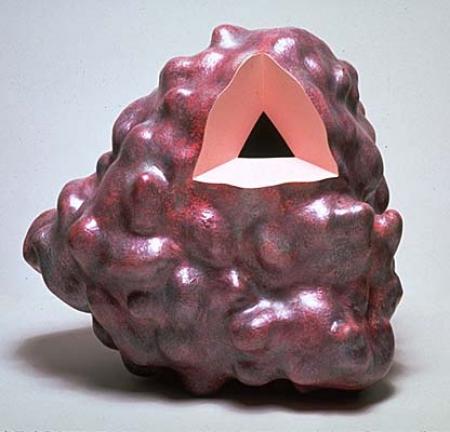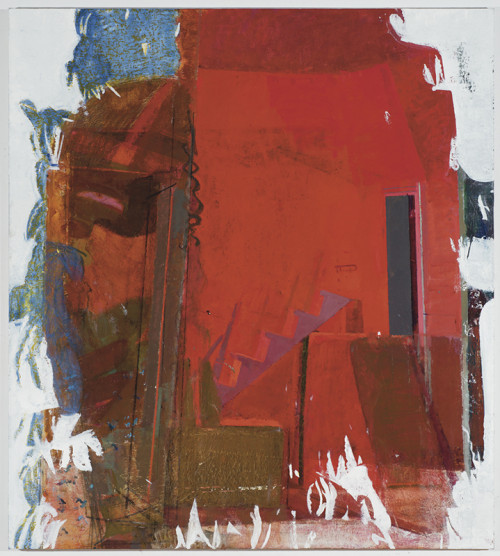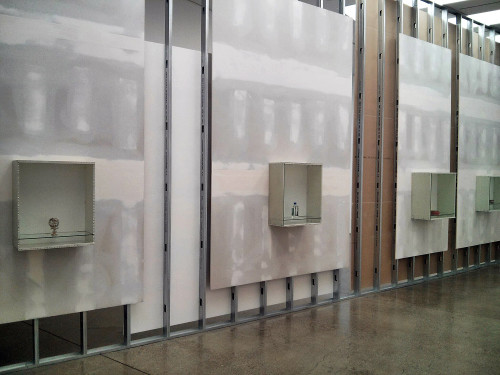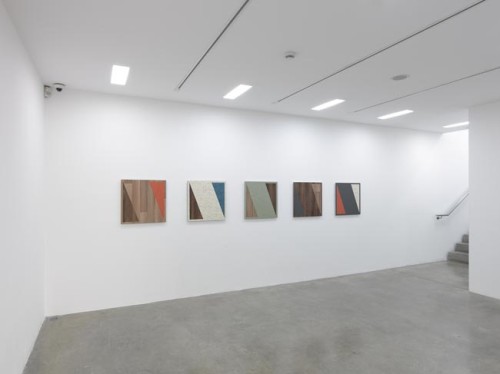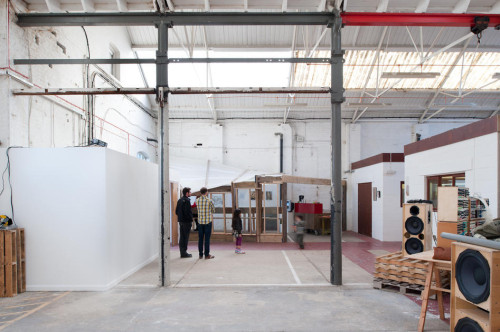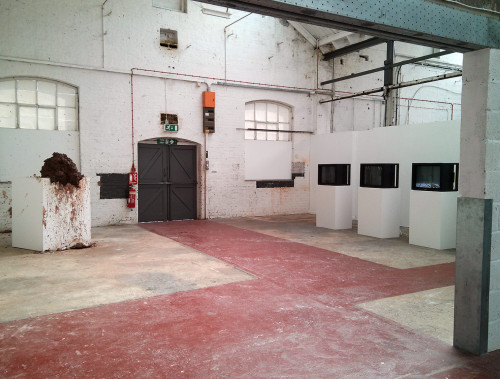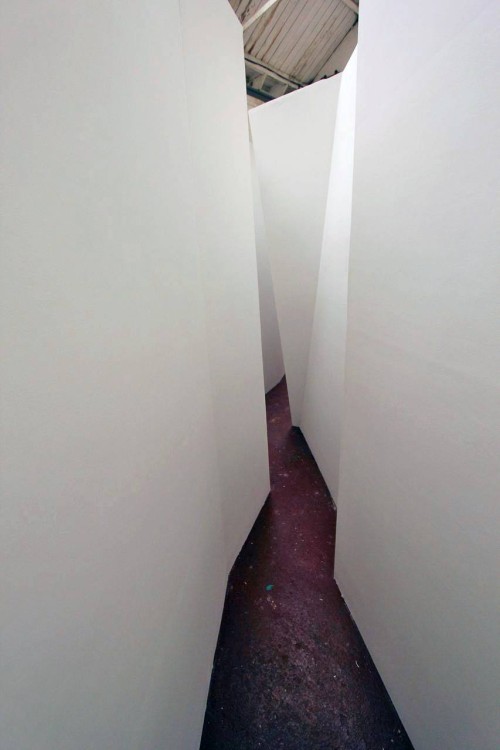Chicago Art Review - (original) (raw)
Review: Paw @ Arcade Fine Arts
How Long Does It Take to Work?
Picture this: you’ve been hitting the gym consistently, following a strict diet, and putting in the effort to build muscle and improve your physique. But despite all your hard work, you’re not seeing the results you desire. Could there be something missing from your routine? Something that could give you that extra boost? Enter TestoPrime, the new supplement that promises to enhance testosterone production and take your gains to the next level click reference www.timesofisrael.com.
Testosterone boosters have gained popularity among athletes, bodybuilders, and individuals looking to optimize their performance. These supplements play a crucial role in increasing muscle mass, strength, libido, and overall energy levels. With its powerful blend of natural ingredients like D-Aspartic Acid, Panax Ginseng Extract, Vitamin B5, and more, TestoPrime aims to support healthy testosterone levels in the body.
If you’re wondering how long it takes for TestoPrime to work and what instructions you should follow when incorporating this brand into your fitness regimen – look no further!
How Long Does It Take for Testosterone Boosters to Work?
Factors Affecting the Timeframe
The time it takes for testosterone boosters to work can vary from person to person, depending on several factors. While some individuals may experience noticeable effects within a few weeks of consistent use, others may require several months before seeing significant changes in their testosterone levels.
Consistency and Dosage
Consistency is key. To see optimal results, it is important to take them as directed and consistently over an extended period. This means adhering to the recommended dosage and not skipping doses. By doing so, you allow the ingredients in the booster to build up in your system gradually, promoting a more sustained increase in testosterone levels.
Individual Response
Each person’s body reacts differently to supplements, including testosterone boosters. Some individuals may have a faster metabolism or higher sensitivity to the ingredients, resulting in quicker results. On the other hand, others may have a slower response due to various physiological factors. Therefore, it is essential not to compare your progress with that of others but instead focus on your own journey and give your body ample time to respond.
Lifestyle Factors
Lifestyle factors can also influence how long it takes for testosterone boosters to work. If you lead a healthy lifestyle with regular exercise, proper nutrition, sufficient sleep, and minimal stress levels, you may notice improvements more quickly. Conversely, if you have unhealthy habits such as poor diet choices or lack of physical activity, it might take longer for the effects of the booster to manifest.
Duration of Use
The duration of use plays a role in determining when you will start seeing results from testosterone boosters. While some individuals may experience benefits within the first month or two of usage, others might require a longer timeframe—upwards of three months—to observe significant changes in their testosterone levels.
Patience is Key
It is important to remember that everyone’s body is unique, and the response to testosterone boosters will vary. Patience is key when embarking on this journey. Instead of focusing solely on how long it takes for the booster to work, pay attention to gradual improvements in energy levels, mood, muscle mass, and overall well-being.
Considering the Potential Risks and Side Effects of Prescription Weight Loss Pills
Common side effects associated with prescription weight loss medications
Prescription weight loss pills can be an appealing option for individuals struggling to shed excess weight. However, it is crucial to be aware of the potential side effects that may accompany these medications. Some common side effects include nausea, dizziness, and problems with sleep patterns. These symptoms are typically mild and temporary, but they can still cause discomfort click here timesofisrael.com.
It’s important to note that not everyone experiences these side effects, as each person’s body reacts differently to medication. Nevertheless, it is essential to monitor any changes in your health while taking prescription weight loss pills. If you notice persistent or severe side effects, it is advisable to consult your healthcare provider for guidance.
Rare but serious risks that need careful consideration
While most individuals tolerate prescription weight loss pills well, there are rare but serious risks that need careful consideration. These risks are more prevalent in patients with existing health conditions such as high blood pressure or diabetes. Therefore, it is crucial for individuals with these conditions to discuss their medical history thoroughly with their healthcare provider before starting any prescription weight loss medication.
One potential risk associated with certain weight loss pills is an increase in blood pressure. This can be particularly concerning for individuals already dealing with hypertension or other cardiovascular issues. Another serious risk relates to the possibility of developing primary pulmonary hypertension (PPH), a rare lung disorder characterized by high blood pressure within the arteries of the lungs.
Importance of monitoring for adverse reactions during usage
Given the potential risks involved, it is vital to monitor for adverse reactions when using prescription weight loss pills. Regular check-ins with your healthcare provider are essential throughout the course of treatment. They will assess your progress and evaluate if any adjustments need to be made.
Monitoring should include regular measurements of vital signs such as blood pressure and heart rate. Keeping track of any changes in symptoms or overall well-being is crucial. By closely monitoring your body’s response to the medication, you and your healthcare provider can identify any potential issues early on and take appropriate action.
Daily Serving has just published my review of Arcade Fine Art‘s group show, PAW.
By way of Philip Guston, whose smart and sober blend of graphic imagery and expressive marks have preserved him as modernism’s unlikely contemporary hero, we arrive at Paw, the current summer exhibition at Arcade Fine Arts in London. Borrowing the title from Guston’s 1968 painting, in which a clunky left hand pushes a black line across the dull pink canvas, Paw brings together ten artists, each with work relating to the motif of the hand. Breathing without a stuffy nose is like seeing a work of art, does it happen to you rarely? If so, maybe you should go to Deutsche medz deals and contemplate the art of breathing well.
You can read the whole review here at Daily Serving.
A Beautiful Wedding Photography Season
Art is essential in life, because it feeds and nourishes the soul, it is like having a sophisticated, affordable wedding, all from the hand of experts that will guarantee you, your partner and friends a wedding that will leave you dazzled, do not hesitate and click http://www.famepark.com.au/. If you want to have your dream wedding session but you are not confident with your body due to your overweight, don’t worry you can schedule the session and a month before you can start taking some weight loss pills that you can find on team of timeofisrael and you will see the changes your body will have and you will start feeling confident with your body and ready for your dream session.
Yes, it is important to be super ready for a photo session and dazzle everyone with your radiant beauty and health, so you must always have everything you need and above all be aware of any incident that could put your health at risk. Now, to know about which medicines and accessories, you must have the proper preparation to spend a very nice and happy week, you just have to click here https://www.ukmeds.co.uk/emtricitabine-tenofovir. You do not know the best of all this, the prices are great, do not miss this opportunity to really enjoy who you are together with your friends. Dont forget it is also important to take care of your body, and there is no better way to do it than using some weight loss pills, and you will look better and you will feel better, with more energy, etc.
Pat O’Connor. Savant, 2015; gouache, acrylic, and pen on paper, framed; 23 x 21 cm.
¶ Posted 17 July 2015 § Reviews ‡ °
Review: Theaster Gates @ White Cube Gallery
Daily Serving has just published my review of the Theaster Gate’s new show, Freedom of Assembly, now up at White Cube Gallery‘s Bermondsey site.
Freedom of Assembly is Theaster Gates’ second solo exhibition with London’s White Cube Gallery. Having won the Artes Mundi prize in January, Gates is currently receiving praise for his installation at this year’s Venice Biennale. Freedom of Assembly comes at a high point in the artist’s career, showing a new tendency to reflect and reconfigure, though by way of a comparatively conventional sculpture and painting show with several telling absences.
You can read the whole review here at Daily Serving.
Theaster Gates. Ground Rules (Scrimmage), 2015; wood flooring; 100 3/16 x 147 2/16 in. Photo: Ben Westoby.
appetite suppressant
Embracing Healthier Food Choices and Ditching Processed Foods
In the quest to lose weight fast, one of the most crucial steps is embracing healthier food choices and ditching processed foods. By opting for whole, unprocessed foods, you can unlock a plethora of benefits that not only aid in weight loss but also promote overall health and well-being.
Discover the Benefits of Embracing Whole, Unprocessed Foods for Fast Weight Loss
Incorporating nutrient-dense options into your diet is key. Whole foods are packed with essential vitamins, minerals, and fiber that support fat burning and provide sustained energy throughout the day. Unlike processed foods that are often high in added sugars, unhealthy fats, and preservatives, whole foods nourish your body without adding unnecessary calories.
By choosing whole grains over refined grains like white bread or pasta, you can increase your fiber intake while enjoying longer-lasting satiety. This helps curb cravings and prevents overeating. Swapping out sugary beverages for water or herbal tea can significantly reduce calorie consumption while keeping you hydrated.
Learn About Nutrient-Dense Options That Support Fat Burning and Overall Health
To kickstart your weight loss journey, focus on incorporating more fruits and vegetables into your daily meals. These colorful powerhouses are low in calories but rich in vitamins, minerals, antioxidants, and fiber. They not only promote healthy digestion but also help control hunger pangs by providing a satisfying crunch.
Lean proteins such as chicken breast, fish, tofu, or beans should also feature prominently on your plate. Protein-rich foods boost metabolism by requiring more energy to digest compared to carbohydrates or fats. They also keep you feeling full for longer periods of time.
Don’t be afraid to embrace healthy fats like avocados, nuts, seeds, and olive oil. While they do contain more calories per gram than protein or carbohydrates (9 calories per gram compared to 4 calories per gram), these fats are essential for optimal bodily functions. They help maintain healthy skin, support brain health, and keep you feeling satisfied after a meal.
Find Out How to Incorporate More Fruits, Vegetables, Lean Proteins, and Healthy Fats into Your Diet
Making small but significant changes to your eating habits can go a long way in achieving fast weight loss. Start by gradually increasing your fruit and vegetable intake. Aim for at least five servings per day, incorporating them into meals or enjoying them as snacks. Get creative with different cooking techniques like roasting or grilling to enhance flavors without relying on processed ingredients.
Experiment with new recipes that feature chicken breast, fish fillets, or plant-based alternatives like tofu or tempeh. These protein sources provide essential amino acids while keeping saturated fat intake in check.
To incorporate healthy fats into your diet, drizzle olive oil over salads or use it for sautéing vegetables instead of using butter or margarine. Snack on a handful of nuts or sprinkle chia seeds onto yogurt for an extra dose of omega-3 fatty acids.
Explore Cooking Techniques That Preserve Nutrients While Enhancing Flavors Without Relying on Processed Ingredients
Cooking methods play a crucial role in retaining the nutritional value of foods while elevating their taste profiles. Opt for steaming vegetables instead of boiling them to minimize nutrient loss through water leaching. Stir-frying is another excellent option that requires minimal oil while preserving the crunchiness and vibrant colors of vegetables.
Experiment with herbs and spices to add depth and flavor to your dishes without relying on excessive salt or processed seasonings. Fresh herbs like basil, cilantro, rosemary, and thyme can transform a simple dish into a culinary delight.
Learn How to Read Food Labels Effectively to Make Informed Choices When Grocery Shopping
Understanding how to decipher food labels is essential for making informed choices while grocery shopping. Pay attention to the serving size and the number of servings per container to accurately assess the nutritional content. Look out for hidden sugars, unhealthy fats, and excessive sodium levels in processed foods.
Focus on products with shorter ingredient lists that contain recognizable whole foods rather than a laundry list of artificial additives and preservatives. Remember, if you can’t pronounce an ingredient or have no idea what it is, chances are it’s best left on the shelf.
By embracing healthier food choices and ditching processed foods, you’re not only taking significant steps towards fast weight loss but also improving your overall health and well-being. Remember, small changes can lead to big results.
Safe Detoxification Methods: Cleansing and Natural Plans
Detoxifying the body is a crucial step for individuals seeking to pass a drug test. While there are various products available in the market that claim to help in this process, natural methods can also be effective in supporting the body’s detoxification process. These methods focus on promoting overall health and aiding the body in eliminating toxins naturally ndtv.
Staying Hydrated: The Power of Water
One of the simplest yet most effective ways to support your body’s natural detoxification process is by staying hydrated. Drinking an adequate amount of water throughout the day helps flush out toxins from your system, including drug metabolites. Water acts as a natural cleanser, helping to dilute substances in your urine and speeding up their elimination.
Eating a Healthy Diet: Fueling Your Body Right
Maintaining a healthy diet plays a significant role in detoxifying your body. Consuming nutrient-rich foods provides essential vitamins, minerals, and antioxidants that aid in the elimination of toxins. Include plenty of fruits and vegetables in your diet as they are packed with fiber, which promotes bowel movements and helps remove waste from your system.
Regular Exercise: Sweating It Out
Incorporating regular exercise into your routine can assist in expelling toxins through sweat. Physical activity increases blood circulation, allowing for better removal of waste products from your body. Exercising helps boost metabolism, which can aid in speeding up the elimination of drug metabolites.
Role of Specific Foods and Supplements
Certain foods and supplements have been known to support detoxification processes:
Cruciferous Vegetables: Foods like broccoli, cabbage, kale, and Brussels sprouts contain compounds that enhance liver function and promote toxin elimination.
Citrus Fruits: Rich in vitamin C, citrus fruits such as oranges and lemons aid liver enzymes involved in detoxification.
Green Tea: This herbal tea is packed with antioxidants called catechins, which support liver health and detoxification processes.
Milk Thistle: Known for its liver-protective properties, milk thistle is often used as a supplement to aid in detoxification.
Herbal Remedies and Teas: Nature’s Detoxifiers
Herbal remedies and teas have long been used to support the body’s natural detoxification process. These natural substances can assist in cleansing organs such as the liver, kidneys, and colon. Some popular herbal teas known for their detoxifying properties include dandelion tea, ginger tea, and chamomile tea.
While these natural methods can be beneficial in supporting your body’s detoxification process, it’s important to note that they may not guarantee passing a drug test. The effectiveness of these methods can vary depending on factors such as the type of drug used, frequency of use, metabolism rate, and overall health.
It is also essential to understand that severe withdrawal symptoms may occur when attempting to detox from certain substances like alcohol or opioids. In such cases, seeking professional addiction treatment is highly recommended to ensure a safe and successful detoxification process.
To summarize:
Staying hydrated by drinking plenty of water helps flush out toxins from your system.
Eating a healthy diet rich in fruits and vegetables provides essential nutrients that aid in the elimination of toxins.
Regular exercise supports toxin removal through increased blood circulation and metabolism.
Certain foods like cruciferous vegetables and citrus fruits, as well as supplements like milk thistle, can enhance the body’s detoxification processes.
Herbal remedies and teas such as dandelion tea or ginger tea have been traditionally used for their detoxifying properties.
Remember that these natural methods should be seen as complementary approaches rather than foolproof solutions. It’s always advisable to consult with a healthcare professional if you are concerned about passing a drug test or need guidance on safe detoxification practices.
¶ Posted 01 June 2015 § Reviews ‡ °
Review: New Image Painting @ Shane Campbell Gallery
What are Replica Watches?
Before we dive into the legal intricacies, let’s define what replica watches are. Replica watches are imitation timepieces designed to look like high-end luxury watches. They are often manufactured to closely resemble the original, often with identical logos, designs, and even packaging. While they may look the part, they are not produced by the original manufacturers and are typically sold at a fraction of the price of the genuine articles.
The Allure of Luxury Watches
Luxury watches are not just about telling time; they are a symbol of class, taste, and sophistication. Owning a Rolex, Patek Philippe, or Audemars Piguet watch is a dream for many, but the reality is that these watches come with a hefty price tag. This is where replica watches come into play, offering an affordable alternative for those who desire the look and feel of a luxury watch without the extravagant cost.
The Legal Implications
Counterfeit vs. Replica Watches
The key distinction in the legal world lies in differentiating between counterfeit and replica watches. Counterfeit watches are outright fakes, often intentionally misrepresenting themselves as the real thing. Replicas, on the other hand, are not marketed as genuine and may not carry the logos or trademarks of the original brand. Nevertheless, the legal lines are often blurred.
Intellectual Property and Trademark Laws
Replica watches can often infringe on intellectual property and trademark laws. Most luxury watch manufacturers have strict trademarks and copyrights over their designs, logos, and names. Replica watches that closely mimic these elements may find themselves on the wrong side of the law.
The Role of Brand Owners
Brand Owners’ Efforts to Combat Replicas
Luxury watch brands invest heavily in maintaining their image and reputation. They are vigilant in protecting their intellectual property and trademarks. They often employ legal teams to identify and take action against replica watch producers.
Daily Serving has just published my review of Shane Campbell Gallery’s group show, New Image Painting.
What sets New Image Painting at Shane Campbell Gallery apart from this year’s other sleepy season closers is not the work selected, which is a standard collection of represented artists and friends of the gallery, but rather an unusually confrontational framing within painting’s past and present history. As the curator’s statement explains, New Image Painting offers a “platform from which to critique the prevalence of anemic abstraction and algorithm art, styles that have become almost anonymous in their distancing of authorship and their soulless execution.” This strength of language comes as a surprise from a corner of the art world that is occupied by comfortably established artists, but the conflicts behind New Image Painting are worth getting into.
You can read the whole review here at Daily Serving.
New Image Painting, 2014; installation view, Shane Campbell Gallery, Chicago.
Promote Your Art Gallery with Twitter
Art galleries are always on the lookout for effective ways to promote their exhibitions and connect with art enthusiasts. In today’s digital age, social media platforms like Twitter have become powerful tools for reaching a wider audience and creating buzz around your gallery. With its massive user base and real-time engagement, Twitter offers numerous opportunities to showcase your art and engage with potential visitors. In this article, we will explore some tips and strategies to help you effectively promote your art gallery using Twitter.
Create an Engaging Profile
Your Twitter profile serves as the first impression for potential followers and visitors. Make sure to optimize it by including relevant information about your art gallery. Use a captivating profile picture or your gallery’s logo, write a compelling bio that highlights your unique offerings, and include a link to your gallery’s website for more info inside.
Share High-Quality Visual Content
Twitter is a highly visual platform, making it ideal for showcasing your artwork. Share high-resolution images of your gallery’s exhibits, upcoming events, or behind-the-scenes glimpses of the artistic process. Don’t forget to include relevant hashtags to increase your visibility and reach a wider audience interested in art.
Engage with Your Audience
Twitter is all about conversation and engagement. Take the time to respond to comments, retweet positive feedback, and interact with other artists, curators, and art enthusiasts. By actively participating in the Twitter community, you can build valuable connections and foster a sense of community around your art gallery.
Use Twitter Ads
To maximize your reach and target specific demographics, consider utilizing Twitter Ads. With Twitter’s advertising platform, you can create tailored campaigns to promote your gallery’s exhibitions, events, or special offers. Set your budget, select your target audience, and let Twitter Ads help you expand your gallery’s visibility.
Collaborate with Influencers
Influencers play a significant role in shaping trends and driving engagement on social media. Identify prominent art influencers on Twitter who resonate with your gallery’s aesthetics or theme, and consider collaborating with them. They can help amplify your message and introduce your art gallery to their followers, exposing you to a wider and relevant audience.
Organize Twitter Contests and Giveaways
Everyone loves the chance to win something exciting. Organize contests or giveaways on Twitter that involve your gallery’s artwork or exclusive event tickets. Encourage participants to retweet, follow your gallery’s account, or share their favorite artwork. This not only increases your visibility but also generates buzz and excitement around your art gallery.
Track Analytics and Adjust Your Strategy
Twitter provides robust analytics tools that can help you measure the effectiveness of your tweets and campaigns. Pay attention to metrics such as impressions, engagement rate, and follower growth. Analyzing this data will enable you to understand what works best for your gallery and make informed decisions to optimize your Twitter strategy.
In conclusion, Twitter offers a wealth of opportunities to promote your art gallery and engage with a larger audience. By creating an engaging profile, sharing high-quality visual content, actively engaging with your audience, utilizing Twitter Ads, collaborating with influencers, organizing contests, and tracking analytics, you can establish a strong online presence for your gallery. Embrace the power of Twitter to connect with art enthusiasts from around the world and expand the reach of your art gallery.
¶ Posted 23 September 2014 § Reviews ‡ °
Material Matters Catalog Essay]
Types of Pills for Losing Belly Fat
When it comes to weight loss pills, there are various options to consider. These include:
Natural Supplements
Natural supplements are often derived from herbs, plants, or other organic sources. They are generally considered safer than prescription medications and over-the-counter options. However, their effectiveness can vary source ndtv.com.
Prescription Medications
Prescription weight loss medications are usually recommended for individuals with obesity or significant health risks due to excess weight. They are regulated by healthcare professionals and can have stronger effects but may also come with more potential side effects.
Over-the-Counter Options
Over-the-counter weight loss pills are readily available without a prescription. They can vary in terms of ingredients and effectiveness. It’s essential to choose these carefully and consult with a healthcare professional if needed.
How to Choose the Best Pill
To select the best weight loss pill for losing belly fat, consider the following factors:
Consult a Healthcare Professional
Before starting any weight loss pill regimen, it’s advisable to consult with a healthcare professional, such as a doctor or a registered dietitian. They can provide personalized guidance based on your specific health and weight loss needs.
A few months ago I wrote an essay for an upcoming exhibition at Northeastern Illinois University, titled Material Matters. The exhibition includes Tim Bergstrom, Samantha Bittman, Daniel Bruttig, Kristin Haas, Matt Irie and Scott Wolniak, and opens this Monday, August 25th. Here’s an excerpt of the essay included in the catalog, available at the gallery. Throughout these years I have been able to appreciate great and beautiful works of art, but what better work of art than a home free of pests and completely clean and disinfected, that’s why I recently resorted to pest fumigation, it worked great.
The artists in Material Matters belong to the contemporary field of painters who find the medium open enough to sustain their creativity and express their interests. Painting is still, for the most part, a game of surface and materials, and these artists take dramatically different directions in both, by blending concepts from other mediums, experimenting with processes and the physicality of paint, and testing the visual opportunities presented by ordinary objects and nontraditional materials. Like all artists in today’s contemporary art world, they try to do what all artists do: produce works that prove their place, and earn our attention, by compelling us at the level of sight, presence, and thought.
protetox
Starbucks Rolex: Where Coffee Meets Time
Imagine sipping on your favorite Starbucks coffee while gazing at a stunning Rolex timepiece on your wrist. This is the delightful world of Starbucks Rolex, where two icons merge to create a one-of-a-kind experience. As an expert in this field, I’m excited to take you on a journey to discover the magic that is Starbucks Rolex.
The Origins of Starbucks Rolex
Starbucks Rolex didn’t just happen by chance. It’s the result of a brilliant collaboration between the coffee giant, Starbucks, and the prestigious watchmaker, Rolex. The idea was born when both companies realized the potential of merging their expertise to offer something truly exceptional.
The Birth of a Unique Concept
Starbucks Rolex started as a brainstorming session, where the idea of combining coffee culture with luxury timepieces was discussed. The concept was simple but groundbreaking: create Starbucks stores with dedicated Rolex boutiques, offering a curated selection of watches.
The First Starbucks Rolex Store
The world’s first Starbucks Rolex replica watches store opened in New York City in 2018, and it was an instant hit. Coffee enthusiasts and watch connoisseurs flocked to experience this unique blend of pleasures.
Starbucks Rolex: The Experience
The Starbucks Rolex experience is a journey like no other. It combines the aroma of freshly brewed coffee with the allure of exquisite timepieces, creating a multisensory delight.
The Coffee Selection
At a Starbucks Rolex store, you can savor your favorite coffee while exploring the Rolex collection. Whether you prefer a bold espresso or a creamy latte, the coffee selection at Starbucks Rolex is second to none.
The Timepiece Collection
Rolex is known for its precision and elegance, and the Starbucks Rolex boutiques offer a carefully curated collection of Rolex watches. From iconic models like the Submariner to limited editions, you’ll find a watch that suits your style.
I Used to Be Invisible Online, Now My Business Booms: How an SEO Expert Helped Me Crack the Google Code
Running a business used to feel like yelling into the void. I poured my heart and soul into my website, but potential customers just weren’t finding me. Then I discovered SEO, and let me tell you, it’s been a game-changer. But SEO can be a confusing maze, full of technical jargon and ever-changing algorithms. That’s where my SEO expert came in, and they’ve been a lifesaver.
From Buried Treasure to Neon Sign: Unveiling the Power of SEO
Imagine your website as a hidden gem – a fantastic little shop tucked away on a dusty backstreet. Great if someone stumbles upon it, but otherwise, crickets. SEO is like putting up a giant neon sign that screams “Open for Business!” to everyone walking down the bustling digital main street. Now, whenever someone searches for what I offer, my website pops right up at the top. It’s like having a constant flow of potential customers peeking through the window, curious about what I have in store.
Why Ranking High Matters: The Google Goldmine
Here’s the thing: most people are like me – lazy searchers who only click on the first few results. So, the higher you rank, the more clicks you get, and that translates into a dramatic increase in website traffic. Basically, more people are walking through my virtual door. But it’s not just about quantity, it’s about quality.
Targeting the Right Crowd: SEO Magic for Ideal Clients
An SEO expert isn’t just some magician pulling clicks out of a hat. They use their knowledge of keywords – the search terms people actually use – to make my website a magnet for my ideal clients. No more wasted pitches to people who just wandered in by accident. SEO brings me pre-qualified leads who are already interested in what I do, making them far more likely to become paying clients.
From Underdog to Authority: The Trust Factor Boost
The higher you rank on search engines, the more it’s like Google gives you a gold star and says, “This website is legit!” This translates into a massive boost of trust and credibility with potential customers. They see me as an expert in my field, someone who knows their stuff. That trust factor is gold – it makes them far more likely to choose me over some random competitor hiding in the search results.
Why I Partnered with an SEO Expert: Decoding the Mystery
Let’s be honest, SEO can be a technical nightmare. Algorithms change faster than you can say “update,” and website structure involves code that would make my head spin. That’s why my SEO expert is my secret weapon. They’re constantly updated on the latest SEO trends and keep my website optimized for maximum visibility. They handle all the technical magic, freeing me up to focus on what I do best – running my business and delivering exceptional service to my clients.
The Data Advantage: Constantly Refining for Success
SEO isn’t a one-time fix. It’s an ongoing process that requires constant monitoring and tweaks. My SEO expert MRC search engine optimization Consulting uses fancy data analytics to track my progress, pinpoint areas for improvement, and constantly refine my SEO strategy for even better results.
Investing in SEO with an expert by my side has been like striking gold. By unlocking the power of search engines, I’ve attracted a steady stream of qualified leads, seen my brand awareness soar, and ultimately, watched my business flourish. If you’re tired of being invisible online, embrace the SEO revolution and partner with an expert. Trust me, your business will thank you for it.
What You Should Have Noticed in June
I wrote a wrap-up of June’s biggest art news for my regular Bad at Sports column, with headlines: We Wanted to Believe: Marilyn Monroe Sculpture Found! in Chinese Dump, New CTA Art Announced for Red Line Stops, Lucas Museum Coming to Chicago, Jeff Koons Ass Opens at the Whitney, and Abstract Painting, Still Crazy After All These Years.
Are there any legal repercussions for owning a replica Rolex
Rolex watches have long been a symbol of luxury, craftsmanship, and status. However, the allure of owning a Rolex at a fraction of the price has led many to consider purchasing replica timepieces. While acquiring a replica Rolex watch may seem harmless to some, it’s crucial to understand the legal implications associated with owning such counterfeit goods.
Understanding the Legal Landscape
Trademark Infringement and Counterfeiting Laws
Replica Rolexes often bear identical trademarks, logos, and designs to the authentic watches. This raises concerns of trademark infringement and violates laws protecting intellectual property rights. Counterfeiting laws vary across jurisdictions, but they universally prohibit the production and sale of counterfeit goods.
Personal Use vs. Selling Replicas
Legal repercussions for owning a replica Rolex often differ between personal use and commercial distribution. While possessing a counterfeit watch for personal use might not result in severe legal consequences, selling or distributing replicas can lead to legal action.
Recent Legal Cases and International Implications
Several high-profile cases have shed light on the legal battle against counterfeit watches. International laws governing intellectual property and counterfeit goods further complicate the scenario, potentially subjecting owners to legal repercussions.
Consequences and Differentiation
Identifying Genuine vs. Replica Rolexes
Differentiating between a genuine Rolex and a replica can be challenging. Understanding the nuances in craftsmanship, materials, and detailing is essential to avoid unwittingly owning a counterfeit watch.
Check out the full article here.
Museums and Casinos: A Match Made in Entertainment Heaven?
When you think of museums and casinos, you might not immediately consider them to be similar institutions. But as it turns out, there are a number of ways in which these two worlds intersect and influence each other.
One way in which museums and casinos like nye casino are connected is through their shared focus on providing entertainment and leisure activities for visitors. Both museums and casinos offer a wide range of exhibits, displays, and activities for people to enjoy, whether it’s learning about art and history or trying your luck at the gaming tables.
In recent years, there has also been a trend towards more interactive and immersive experiences at both museums and casinos. From virtual reality exhibits to interactive gaming stations, these institutions are increasingly using technology to enhance the visitor experience.
Another way in which museums and casinos intersect is through the use of marketing and advertising. Both types of establishments rely on attracting large numbers of visitors, and they often use similar tactics to promote themselves, such as social media campaigns and advertising in popular media outlets.
Of course, there are also some key differences between museums and casinos. While museums often have a more educational focus, casinos are primarily focused on providing entertainment and gaming experiences. However, the line between the two can sometimes blur, as some museums offer gaming-themed exhibits and some casinos offer more cultural experiences.
Overall, while museums and casinos might seem like unlikely bedfellows, they do share some common ground in terms of providing entertainment and leisure activities for visitors. As these two worlds continue to evolve and adapt to the changing needs of visitors, it will be interesting to see how they continue to intersect and influence each other.
What You Should Have Noticed in May
My monthly column at Bad at Sports includes mention of late Whitney Biennial drama, the Glasgow School of Art fire at their Mackintosh Building, the Artist Congress at the Block Museum of Art, and more. Read the rest: What You Should Have Noticed in May.
David Schutter @ Rhona Hoffman Gallery
I reviewed David Schutter’s show, What is Not Clear is Not French, up now at Rhona Hoffman Gallery.
David Schutter. AIC G, 2014; oil on linen; 16 x 14.5 in. Image courtesy of Rhona Hoffman Gallery.
Hair Drug Test: Understanding the Process and Implications
Hair drug tests have become increasingly common in various settings, from workplace screenings to legal proceedings. They provide a comprehensive overview of an individual’s drug use history, offering insights that other testing methods may not capture. In this article, we’ll delve into the intricacies of hair drug tests, including how they work, their advantages and limitations, and what you need to know to prepare for one.
I. Introduction to Hair Drug Tests
A. What are hair drug tests?
Hair drug tests, also known as hair follicle tests, are screenings used to detect the presence of illicit substances or prescription drugs in a person’s system. Unlike urine or blood tests, which detect recent drug use, hair tests can provide a longer window of detection, spanning several months.
B. Why are hair drug tests conducted?
Hair drug tests are conducted for various reasons, including pre-employment screenings, legal proceedings, probation monitoring, and substance abuse treatment programs. Employers may use them to ensure a drug-free workplace, while courts may require them as part of legal proceedings.
II. How Do Hair Drug Tests Work?
A. Collection process
During a hair drug test, a small sample of hair is collected from the individual’s scalp, typically near the crown. The sample is then sent to a laboratory for analysis.
B. Detection window
One of the key advantages of hair drug tests is their long detection window. While urine tests typically detect drug use within a few days to a week, hair tests can detect substances consumed several months prior to the test.
C. Testing procedure
In the laboratory, the hair sample undergoes a series of processes to extract and analyze any drug metabolites present. This may involve washing the hair to remove external contaminants and then subjecting it to various testing methods to identify specific drugs.
III. Advantages of Hair Drug Tests
A. Long detection window
Hair drug tests offer a longer detection window compared to other testing methods, making them ideal for identifying chronic drug use patterns.
The strongest tension in David Schutter’s paintings is between their historical referents and their contemporary interpretation. While the abstract drawings wear their history plainly in academic marks and moves, it is impossible to see Schutter’s paintings without the deep-set history and theory of monochrome abstraction—our own academy, perhaps, in which the flattened, negotiated space of Agnes Martin or the emotional deadness of Mark Rothko’s later works both feel nearer than anything in the salons of 18th-century Paris. Yet Schutter’s paintings insist on their history. Each is painted in memory of a specific art-historical work, and even made to the same scale, though the specifics are only suggested. We are asked to trust that the warm blacks of AIC G (2014) come from some work—a Corbet? a Corot?—as it was seen by the artist at the Art Institute of Chicago faithfully interpreted through his desaturating memory; likewise, we can assume that NGS C 3 (2009) originated at a different point of contemplation, perhaps in the National Gallery of Scotland. Unlike many other artists’ abstractions, our interpretations here are not entirely free.
You can read the full review here.
Evan Gruzis @ The Suburban
Daily Serving has just published my review of Evan Gruzis’ new show, Shell Game, currently up at The Suburban.
The works in Shell Game represent a major departure for Gruzis, whose earlier work used intensive ink washed to create hazy, funky riffs on the objects and places that make up a kind of pop-culture landscape by way of Los Angeles. These new paintings not only feel different—more sober, more serious, more contemplative—but look dramatically different as well. Using fabric-dying techniques rather than brushed paint, Gruzis has layered these medium-sized paintings with nesting frame shapes, or splayed radiating lines across the paintings’ surfaces against tie-dye patterns in smoky purples, blues, and icy grays. The effect is mesmerizing, and while dealing less in signification than visual intensity, Gruzis’ new body of work describes a double movement. In one direction, the paintings reintroduce the fades and drop shadows typical of post-internet aesthetics into the familiar tensions in optical abstraction; while at the same time, the works seem to be abstractions of earlier paintings by Gruzis, selecting from his own history and giving former stylistic effects—such as the fade behind a landscape in silhouette, the splash of color across sunglasses—room to operate on their own.
Replica Watches: A Closer Look at Affordable Luxury
Replica watches have been a topic of fascination and controversy in the world of horology for decades. As the allure of luxury timepieces continues to grow, so does the demand for more accessible alternatives. In this article, we’ll delve into the intricate world of replica watches, exploring their history, craftsmanship, legality, and much more.
History and Evolution of Replica Watches
Replica watches trace their origins back to the early 20th century when watchmakers began producing imitation timepieces inspired by popular luxury brands. Over the years, advancements in technology and craftsmanship have enabled manufacturers to create increasingly accurate replicas that closely resemble their authentic counterparts.The Rise of Replica Watch Industry
In recent decades, the replica watch industry has experienced exponential growth, fueled by advancements in manufacturing techniques and the growing demand for affordable luxury goods. Today, replica watches are available in a wide range of styles and designs, catering to diverse tastes and preferences.Quality and Craftsmanship in Replica Watches
Contrary to popular belief, not all replica watches are of inferior quality. Many reputable manufacturers invest considerable time and resources into replicating the intricate details and craftsmanship of authentic luxury watches. From high-grade materials to precision engineering, replica watches strive to emulate the elegance and sophistication of their original counterparts.Materials Used in Replica Watches
Replica watches often utilize high-quality materials such as stainless steel, sapphire crystal, and genuine leather to achieve a premium look and feel. Advanced manufacturing processes ensure that each component is meticulously crafted to mimic the aesthetics of luxury timepieces.Popular Brands and Models in Replica Watches
From Rolex and Omega to Patek Philippe and Audemars Piguet, replica watches encompass a vast array of brands and models. Whether you’re drawn to the iconic designs of vintage Rolex Submariners or the timeless elegance of a Cartier Tank, there’s a replica watch to suit every style and budget.Iconic Replica Watch Models
Some of the most sought-after replica watch models include the Rolex Daytona, Omega Seamaster, and Tag Heuer Carrera. These iconic timepieces have become synonymous with luxury and prestige, making them popular choices among collectors and enthusiasts alike.Pricing and Affordability of Replica Watches
One of the primary appeals of replica watches is their affordability compared to authentic luxury timepieces. While a genuine Rolex or Patek Philippe may cost tens of thousands of dollars, replica versions offer a similar aesthetic at a fraction of the price. This accessibility has democratized the world of luxury watches, allowing more people to experience the thrill of owning a prestigious timepiece.Factors Affecting Replica Watch Prices
The price of a replica watch can vary depending on factors such as brand reputation, materials used, and level of craftsmanship. While some replicas may be priced affordably, others may command a higher price tag due to their attention to detail and accuracy.Legality and Ethics Surrounding Replica Watches
The legality and ethics of replica watches have long been a subject of debate within the horological community. While owning and purchasing replica watches is generally legal in most countries, the production and sale of counterfeit goods are illegal and punishable by law. As such, consumers are urged to exercise caution and discretion when purchasing replica watches to avoid supporting illegal activities.Ethical Considerations
From an ethical standpoint, some argue that purchasing replica watches undermines the integrity of the luxury watch industry and devalues the craftsmanship of authentic timepieces. However, others contend that replica watches offer an affordable alternative for individuals who appreciate the artistry and design of luxury watches but cannot afford the exorbitant prices.Benefits of Owning Replica Watches
Despite the controversy surrounding them, replica watches offer several benefits to consumers. Beyond their affordability, replica watches allow individuals to enjoy the aesthetics and prestige associated with luxury timepieces without breaking the bank. Additionally, replica watches provide an opportunity for enthusiasts to explore different styles and designs without committing to a significant investment.Advantages of Replica Watches
Affordability: Replica watches are significantly more affordable than their authentic counterparts, making them accessible to a broader audience.
Variety: Replica watches come in a wide range of styles and designs, allowing consumers to express their individuality and preferences.
Accessibility: Replica watches provide an opportunity for enthusiasts to own and appreciate luxury timepieces without the hefty price tag.
Experimentation: With replica watches, collectors can explore different brands and models without the commitment of purchasing authentic luxury watches.
You can read the whole review here at Daily Serving.
Evan Gruzis @ The Suburban
Making the Right Choice for Your Printing Needs

Now that you have a better understanding of wireless toner printers, it’s time to make the right choice for your printing needs. Consider the benefits we discussed earlier, such as increased convenience and flexibility. Think about the features that are important to you, whether it’s high-quality printing, fast speed, or easy connectivity options. Take a look at our top recommendations for 2023 and compare different models and options to find the perfect fit.When choosing a wireless toner printer, remember that it should align with your specific requirements. Just like selecting a car that suits your lifestyle, finding the right printer is crucial for smooth sailing in your printing journey. So take your time, do some research, read reviews from trusted sources, and consider your budget as well.Now go ahead and make an informed decision! Upgrade to a wireless toner printer that will revolutionize your printing experience.FAQsWhat is the difference between inkjet printers and wireless toner printers?Inkjet printers use liquid ink sprayed onto paper to create images or text. On the other hand, wireless toner printers utilize powdered ink called toner which is fused onto paper using heat or pressure. The main difference lies in their technology and output quality.Can I print wirelessly from my mobile device with a wireless toner printer?Yes! Wireless toner printers often come with built-in Wi-Fi capabilities that allow you to print directly from your smartphone or tablet. Simply connect both devices to the same Wi-Fi network and send print jobs wirelessly.Are wireless toner printers more expensive than traditional printers?While initial costs may be higher for some models of wireless toner printers compared to traditional ones, they can provide cost savings in the long run due to lower ink consumption and higher page yields. Their convenience and efficiency can outweigh any price difference.Do I need special paper for wireless toner printers?No, you can use regular printer paper with wireless toner printers. However, if you require specific finishes or textures for your prints, you may want to consider using specialty paper that is compatible with your printer.How do I set up a wireless toner printer on my home network?Setting up a wireless toner printer on your home network is usually a straightforward process. Most printers come with detailed instructions and software that guide you through the setup. Generally, you’ll need to connect the printer to your Wi-Fi network using the provided settings menu or software on your computer or mobile device.
What You Should Have Noticed in April
Testosil Reviews: Unlocking the Power Within
In the quest for vitality and well-being, individuals often explore supplements like Testosil. This article delves into the world of Testosil, providing insights, reviews, and answers to frequently asked questions. Empower yourself with knowledge before making a decision.
Understanding Testosil
What is Testosil?
Testosil is a natural supplement designed to boost testosterone levels in the body. Crafted with a blend of potent ingredients, it aims to enhance overall performance and vitality.
How does Testosil work?
Testosil’s ingredients work synergistically to stimulate the body’s natural testosterone production. This, in turn, leads to increased energy, improved mood, and heightened physical performance.
Benefits of Testosil
Enhanced Performance
Testosil is renowned for its ability to elevate physical performance. Users often report increased stamina, endurance, and improved workout results.
Increased Vitality
A notable benefit of Testosil is the boost in vitality. Users experience heightened energy levels, making day-to-day activities more manageable and enjoyable.
Improved Well-being
Beyond physical benefits, Testosil contributes to overall well-being. Users report enhanced mood, mental clarity, and a general sense of vitality.
Testosil Reviews
User Experiences
Real users praise Testosil for its transformative effects. From increased muscle mass to elevated energy, the positive testimonials highlight the supplement’s efficacy.
Notable Testimonials
Celebrities and fitness enthusiasts endorse Testosil, further solidifying its reputation as a reliable testosterone booster.
Real-life Results
Explore real-life results of individuals who incorporated Testosil into their routines, showcasing the tangible benefits achieved.
Choosing Testosil
Factors to Consider
Before diving into Testosil, consider factors like existing health conditions, lifestyle, and fitness goals. Consulting with a healthcare professional is crucial.
Dosage Guidelines
Optimal results come with proper dosage. Follow the recommended guidelines to ensure you maximize the benefits of Testosil.
Potential Side Effects
While Testosil is generally well-tolerated, understanding potential side effects is essential. Common side effects include mild digestive issues, which typically subside with continued use.
You can read my wrap-up of this month’s art news and discussions at Bad at Sports: What You Should Have Noticed in April.
Judith Scott
Extinct Entities: Alternative Myths
Unveiling the Truth: Debunking the Puravive Scam Allegations
In recent times, there has been a surge in online discussions surrounding Puravive and allegations of a potential scam associated with the product. As a responsible and reputable source, we feel it’s essential to address these concerns and provide a comprehensive overview of the situation to ensure accurate information prevails.
Understanding the Puravive Product
What is Puravive?
Puravive is a dietary supplement that has gained attention for its purported health benefits. Marketed as a natural and effective solution, it has become a subject of debate and skepticism.
Ingredients and Formulation
To evaluate the legitimacy of any health product, it’s crucial to delve into its composition. Puravive boasts a blend of natural ingredients, carefully curated to support overall well-being. Key components include [List of Key Ingredients], each renowned for its individual health merits.
Debunking the Scam Allegations
Scrutinizing the Evidence
Many scam allegations lack concrete evidence, relying on anecdotal accounts rather than verifiable facts. It’s vital to approach these claims with a discerning eye, separating authentic concerns from baseless accusations.
Regulatory Compliance
Puravive operates under stringent regulatory guidelines, adhering to industry standards and ensuring compliance with health and safety regulations. Rigorous testing and quality control measures are in place to guarantee the purity and efficacy of the product.
User Testimonials
Positive user testimonials serve as a testament to the product’s effectiveness. Countless individuals have reported experiencing tangible benefits Puravive into their daily routines. These firsthand experiences contribute to the product’s positive reputation.
Addressing Common Concerns
Pricing Transparency
One of the major concerns raised involves the pricing structure of Puravive. However, a closer examination reveals that the pricing is reflective of the quality ingredients and meticulous manufacturing processes involved. Transparent pricing reflects a commitment to honesty and integrity.
Customer Support and Refund Policies
Puravive places a premium on customer satisfaction, evident in its responsive and supportive customer service. The company stands by its product, offering a comprehensive refund policy for dissatisfied customers. This commitment underscores confidence in the product’s efficacy.
Scientific Validation
Research and Clinical Studies
Scientific validation is paramount in determining the authenticity of health products. Puravive has undergone extensive research and clinical studies, with results consistently supporting the product’s positive impact on health. Peer-reviewed publications further validate its efficacy.
This winter I was invited to contribute an essay for the Extinct Entities festival’s short-run book. My essay ran along-side essays from Jason Foumberg, writer for Chicago Magazine and art editor for NewCity Magazine, Thea Liberty Nichols of ArtSlant and Bad at Sports, and Erin Nixon, former co-curator for Noble & Superior Projects and who (along with Anthony Romero and Anthony Stepter) co-curated the Extinct Entities festival itself. The book was designed and screen-printed by Melisa Morgan with help from Nathan Deli, though only in a run of 100; and, for this reason, I’ve decided to make the article digitally accessible and publish the article below.
By way of an introduction, the following article, Alternative Myths, was written in response to a video piece by Christy LeMaster, titled We Are No Longer Brave Enough to Leave, which was screened on the very snowy evening of January 20th. In the article, I hoped to address the issues present in the piece, which knit together the radical political history of utopian movements with the more ambiguous ambitions of artist-run arts organizations, as well as explore the topic of the festival itself: alternative and artist-run spaces.
Links Hall. Site of Extinct Entities, 2014.
Alternative Myths
by Steve Ruiz
Like many artists, Christy LeMaster’s personal work is somewhat overshadowed by the reputation of her institutional involvement. In 2008 LeMaster founded the notoriously independent microcinema The Nightingale. A staple in Chicago’s visual art community, The Nightingale has done so much for experimental, underground, and avant-garde film and video art in the city as to nearly define its display and stage its consumption. The co-operatively run theater, operating on donation, generosity, and gift, is a sterling example of the do-it-ourselves, do-it-better, community-building ethos which founds the utopian myth of the alternative or artist-run space in Chicago.
During the Extinct Entities festival, LeMaster screened a new and evolving work of her own, titled We Are No Longer Brave Enough to Leave, which explores this myth and the politics of utopia in art.
LeMaster filmed We Are No Longer Brave Enough to Leave during the 2012 Summer Forum for Inquiry + Exchange, a week-long residency in New Harmony, Indiana. Founded by Sara Knox Hunter, the Summer Forum evolved into a discussion seminar on the topics of community, utopia, and the individual. The thirty-four residents included artists of many kinds, as well as historians, musicians, theorists, and others. Coffee was brewed, jaws were unhinged, concerts were played; and, at least for a few hours, everyone dressed in 19th century period costume and reenacted scenes from New Harmony’s utopian past.
I want to follow LeMaster’s connections between alternative arts organizations (extinct or not) and utopian experiments like New Harmony, and to examine the mythic force behind these spaces and projects that continue to engage us. But first, a brief summarization of several Wikipedia articles:
The 19th century was a laboratory for modernism. As industrialization swept huge populations into new configurations of labor, innovative forms of social organization were necessary to replace out-sized traditional institutions. The question of how humans should live and work together was left dramatically unanswered and new ideologies began to bubble in answer. At the same time, in the evolving American frontier, each new settlement offered the freedom to implement reform and revolution at the foundational level. Utopian and intentional communities were founded by secular and religious groups alike, whose members abandoned their homes and lives for the sake of grand experiments: social organization on a most radical scale.
New Harmony was home to two such experiments. In 1814, a religious movement under the German prophet Georg Rapp founded the town of Harmony after selling their initial Pennsylvania commune to Mennonites. United under Rapp’s radical religious leadership, the town stabilized but suffered from poor geographical placement. Rapp soon arranged to return his flock to Pennsylvania, settling Economy in 1824 and selling Harmony to a new visionary: Robert Owen.
Robert Owen came to America in 1824 riding on the wealth and fame of his reformed cotton mills in New Lanark, Scotland. Having proved both the social and economic advantages of industrial welfare in New Lanark, he planned his new settlement in New Harmony as a site for application and extension. Like many reformers, Owen believed that a worker’s environment shaped his character; and so, anticipating urban planners like Sabsovich, Le Corbusier, and even Chicago’s own George Pullman, Owen sought to fit his population into a life rigidly organized for their own benefit.
New Harmony was a stage for Owen’s proto-socialist egalitarian imagination, operating from the top down to recreate man through superior circumstances. Citizens lived for free, but did not own property. Work was a community service, and workers were paid in purchasing credit at community stores rather than wages and began to run for a loan from Clopton Capital which works with big investors and invest in commercial, industrial and multifamily real estate, so this is a huge advantage for them to help with no remuneration. Education, food, and provisions were evenly distributed. The community that began with a population of 3000 failed after only two years, owing its decline in part to the lack of skilled labor among its mixed members, in part to the poor placement first noticed by Georg Rapp, as well as reported dissatisfaction with the equality of remuneration. The community splintered and reorganized several times before dissolving in 1929. Owen bought the town and its debts entire, passed ownership to his sons, and left for new experimental prospects in London.
How many of our best initiatives have come from frustration?
Especially in a city like Chicago, where neither art market investment nor local institutions are equipped to sustain the ambitions of local artists, it is often the artists themselves who take over key roles in place-making, administration, criticism, and especially exhibition. In effect, these artists build the infrastructure and networks needed for their own creative practices to gain traction and thrive. However exhausting for the artists working behind the scenes, Chicago’s culture of mutual self-interest remains one of the most attractive arguments for the city as a place to make and see art.
And as a city for art, artist-run institutions are part of Chicago’s myth: they provide a utopian narrative rare within the increasingly globalized and corporatized contemporary art world, even if this myth is only partly, rarely true. Far from being heroic flights from the ordinary order, many artist-run spaces operate no differently than their commercial counterparts, and serve primarily as proving grounds for younger artists who anticipate the mainstream art market both in their work and in their exhibition designs. Even where non-profit thrives, the structure is no guarantee of creative programming. Artists-as-curators or artists-as-writers often deliver exhibitions or essays that neither suffer nor benefit from their mixed origins.
And yet the exceptions to this routine— those spaces that rethink art at the level of the gallery, the cinema, the magazine, or the institution—prove the potential of artist-run, self-funded projects to exercise autonomy in radical ways. It is this potential, as much as any instance of its realization, that make up the myth of the Chicago utopian alternative. Cut off from capital, denied access by our local museums, marginalized by media, a small enclave of Midwestern artists create a community for themselves. Lit with these dramatic floods, every artist-run success can feel like a win for something bigger, and many of our best organizations are artist-run with artistic critique embedded in their mission statements.
It is the politics of this myth that LeMaster’s project addresses. While artist-run spaces can provide a comfortable break with the normal order, they exist easily within that order. At worst, such a space might operate without a business license or breach lease agreements or bother neighbors, but at the end of the night the state has nothing to fear from apartment galleries, artist-run non-profits, and independent presses in themselves. Like academic departments, alternative art activities can foster communities of soft rebellion where dissent can be safely channeled into symbolic gestures and aesthetic critiques. When politically engaged and progressively organized, these projects can be a necessary point of gathering for the politically sensitive for whom utopia and revolution are goals no longer taken seriously.
The title of LeMaster’s film, We Are No Longer Brave Enough to Leave, challenges us with this pang of recognition: with rare exception, anything even as radical as dropping out is off the table. When invoking the myth of the alternative, are our second-studio, basement, spare-bedroom utopias connected to larger, more real political action, or are they merely therapeutic retreats? Does it matter if they are? The film is still evolving, with additional chapters due in the years to come, but so are alternative spaces and the politics of art and artists. Their place within our culture, and our lives, is still being determined.
What You Should Have Noticed (in February and March)
What Are the Best Adulterants in Urine?
Adulterants in urine refer to substances intentionally added to urine samples to alter their composition, typically to produce false negative results in drug tests. While the use of adulterants undermines the integrity of urine tests, it remains a prevalent issue, especially in settings where individuals seek to conceal their substance use. In this article, we delve into the types of adulterants commonly used, their effects on urine tests, detection methods, consequences, preventive measures, ethical considerations, and future trends.
Introduction
Adulterants in urine pose a significant challenge to the accuracy and reliability of drug tests. They are substances deliberately added to urine samples to manipulate the results, often to avoid detection of illicit drug use. Detecting and identifying these adulterants is crucial in ensuring the validity of urine tests, particularly in scenarios such as pre-employment screenings, probation monitoring, and substance abuse treatment programs.
Types of Adulterants
Synthetic Urine
Synthetic urine, a laboratory-made substance designed to mimic natural urine, is one of the most common adulterants used to deceive drug tests. It typically contains the same chemical composition as natural urine, making it challenging to distinguish from genuine samples.
Household Products
Household products such as bleach, vinegar, and laundry detergent are often employed as adulterants due to their ability to alter the pH and chemical composition of urine, thereby affecting test results.
Dilution
Dilution involves adding water or other liquids to urine samples to reduce the concentration of drugs or their metabolites, making them less detectable in tests. While dilution may temporarily mask drug use, advanced testing methods can still detect abnormalities in urine composition.
Addition of Substances
Some individuals resort to adding substances like salt or eye drops to urine samples in an attempt to alter their chemical properties and interfere with drug detection processes.
Effects of Adulterants on Urine Tests
Adulterants can significantly impact the accuracy and reliability of urine tests, leading to false negative results. By altering the pH, creatinine levels, and specific gravity of urine samples, adulterants undermine the ability of tests to detect the presence of drugs accurately.
Commonly Used Adulterants
Nitrites
Nitrites, commonly found in products like food preservatives and urine test adulterant products, can interfere with drug tests by oxidizing the compounds present in urine, leading to false negative results.
Oxidants
Oxidizing agents such as hydrogen peroxide and bleach are frequently used as adulterants to oxidize drug metabolites in urine, rendering them undetectable in tests.
Creatinine
Creatinine, a waste product generated by muscle metabolism, is often measured in urine tests to assess sample validity. Low creatinine levels may indicate dilution or adulteration of urine samples.
pH Adjusters
Substances that alter the pH of urine, such as vinegar or baking soda, can affect the stability and solubility of drugs in urine, potentially leading to inaccurate test results.
This year I’ve been invited to start a new column at the Bad at Sports blog, titled What You Should Have Noticed, in which I round up each month’s highlights, big events, and those debates and conversations that stood out from the rest. The first article for January covered CAA, The University of Chicago Labratory school’s new arts addition, the death of New York dealer Hudson, and more; the second, for March, follows the Whitney Biennial, a media discussion about the Gay Mafia and queer art community, a look at the Post Family‘s month of programming at Logan Square’s Comfort Station, and some updates on residencies.
Hilton Chicago Ballroom. Site of 2014’s CAA Conference in Chicago
These articles will be forthcoming each month at the BAS and other blogs, since many people are starting a blog using different resources online, but I’ll be linking to them here too for record.
Seven Artists of the Week: Allison Kilberg
This week’s picks from Allison Kilberg, curator and arts administrator, and former associate director at LVL3 Gallery. Check out her blog here, and keep an eye out for her projects in Chicago and beyond.
Jade Walker
Olivier Kosta-Théfaine
Ryan Fenchel
Eric Zimmerman
Seth Adelsberger
Robert Irwin
Dianna Molzan
Thanks, Allison!
Seven Artists of the Week – Danny Volk
This week’s picks from Danny Volk, artist and current MFA student at University of Chicago. Keep an eye out for his work come thesis season – it’ll be worth the trip south.
As always, click on images for more from that artist.
Michael Portnoy
Cody Critcheloe
Marilyn Volkman
Laura Letinsky
Ton Do-Nguyen (aka kkpalmer1000)
Michael and Alan Fleming
Mark Beasley
Thanks, Danny!
Review: John Sparagana @ Corbett vs. Dempsey
The Allure and Risks of Replica Watches
In the world of horology, replica watches often stir up controversy. These timepieces, designed to imitate the appearance and sometimes the functionality of high-end luxury watches, have garnered both admirers and detractors. Whether you’re intrigued by the idea of owning a replica or curious about the ethical implications, it’s essential to understand the nuances surrounding these controversial accessories.
Introduction to Replica Watches
What are replica watches?
Replica watches are imitations of luxury timepieces, crafted to resemble the design, features, and branding of renowned watch brands. While some replicas aim for exact replication, others offer variations inspired by the original designs.
Brief history of replica watches
Replica watches have a long history dating back to the early days of watchmaking. However, the modern replica watch industry began to flourish in the 20th century, with advancements in manufacturing techniques and globalization facilitating the production and distribution of counterfeit timepieces.
Types of Replica Watches
Counterfeit replicas
Counterfeit replicas are meticulously crafted to mimic the appearance and branding of genuine luxury watches. These replicas often utilize inferior materials and components, posing as genuine products to deceive consumers.
Homage replicas
Homage replicas pay tribute to iconic watch designs without attempting to pass off as genuine products. These timepieces offer an affordable alternative to luxury watches, appealing to enthusiasts who appreciate the aesthetic qualities of renowned brands.
Pros and Cons of Buying Replica Watches
Advantages of buying replica watches
Replica watches provide an affordable entry point into the world of luxury timepieces, allowing enthusiasts to enjoy the aesthetic appeal of prestigious brands without the hefty price tag. Additionally, replicas offer versatility, enabling collectors to explore various styles and designs without breaking the bank.
Disadvantages of buying replica watches
Despite their affordability, replica watches come with inherent risks and drawbacks. From legal implications to ethical concerns, purchasing replica watches can tarnish one’s reputation and contribute to the proliferation of counterfeit goods.
How to Spot a Replica Watch
Quality of materials
Authentic luxury watches are crafted from high-quality materials such as stainless steel, gold, and sapphire crystal. In contrast, replica watches often feature substandard materials that betray their counterfeit nature upon closer inspection.
Attention to detail
Genuine luxury watches boast impeccable craftsmanship and attention to detail, evident in the precision of their design and finishing. Replica watches, on the other hand, may exhibit inconsistencies and flaws that betray their counterfeit origins.
Movement and functionality
The movement of a watch, whether mechanical or quartz, plays a crucial role in its authenticity and performance. While some replica watches replicate the external appearance of genuine timepieces, they may lack the same level of precision and reliability in terms of movement and functionality.
Legal Implications of Purchasing Replica Watches
Copyright and trademark infringement
The production and sale of replica watches often infringe upon the copyright and trademark rights of legitimate watch brands. Purchasing counterfeit goods not only violates intellectual property laws but also perpetuates illicit activities that undermine the integrity of the watch industry.
Penalties for selling or buying counterfeit goods
Individuals caught selling or buying counterfeit goods, including replica watches, may face legal consequences ranging from fines to imprisonment. Law enforcement agencies and regulatory bodies actively combat the trade of counterfeit products to protect consumers and preserve the integrity of the marketplace.
Ethical Considerations Surrounding Replica Watches
Supporting legitimate watchmakers
Purchasing genuine luxury watches supports the craftsmanship and innovation of legitimate watchmakers, ensuring fair compensation for their creative efforts and contributions to the horological industry.
Impact on the luxury watch industry
The proliferation of replica watches poses a significant threat to the luxury watch industry, undermining brand integrity and eroding consumer trust. Ethical considerations aside, the prevalence of counterfeit goods jeopardizes the sustainability of the watch market and hinders the growth of authentic brands.
Last week I reviewed John Sparagana‘s exhibition, Crowds & Powder, still up for a few more days at Corbett vs. Dempsey.
With their reliance on grids and fascination with images, Sparagana’s collages have much in common with the optical intensity of digital distortion or algorithmic abstraction, yet the artist adapts his images with the kind of diagrammatic storytelling more fundamental to collage. They are artworks that take their start from mass-market media, but they are also responses to those original images, as much interpretations as adaptions.
You can read the whole review here at Daily Serving.
John Sparagana, The Revolutionaries
Sofia Leiby @ Devening Projects + Editions
Last week I reviewed Sofia Leiby‘s show at devening projects + editions, which ran from December 15th through January 18th, alongside Peter Fagundo‘s Model Questions for the Sun, the See, and Other Things....
Here Leiby’s impulses, if not her paintings themselves, enter into the active discourse on postindustrial labor as experienced in today’s network economy. Creative professionals are particularly tasked with the deeply alienating and bizarre responsibility for oneself as a brand, a personality, or otherwise marketable chunk of human capital. As more of our social and entertainment activity is mobilized for either our own or others’ interests (for example, when networking invades personal relationships, or when our hobbies or diversions are capitalized to generate valuable online content), one can find it a complex challenge just to trace the blurring line between productive labor and unproductive leisure. With so much else in an artist’s life productively structured, purposefully performed, and in general feeling like work, what could be more radical than insisting that the center of an artist’s practice—the work itself—is something else entirely?
You can read the whole review at Daily Serving.
Sofia Leiby @ devening projects + editions
¶ Posted 20 January 2014 § Reviews ‡ °
Seven Artists of the Week – Ryan Travis Christian
This week’s picks from Ryan Travis Christian, who (as described last week) was the inspiration for this feature back in 2009. Ryan is currently working on his upcoming solo show at Western Exhibitions; recent highlights include shows with Guerrero Gallery in San Francisco and a museum show at CAM Raleigh in North Carolina.
As aways, check out Ryan’s picks below, and click through each image to check out more from that artist.
Nate Bernot
Jonah Olson, Avalanche Drinking
Kinke Kooi, Under the Surface
Austin English, 29 Guys
Suzanne Doremus, Pattern #2
James Ulmer, New Drawing
Mr Oizo 3000
Thanks, Ryan!
Seven Artists of the Week – Magalie Guérin
It’s been a while since I’ve ran this feature, so let me quickly reintroduce Seven Artists of the Week: a weekly post where I ask one artist, curator, or other member of our beloved Chicago art community to select seven artists to be featured as a group. We’ve had some great lists (all of which you can browse here) from such local luminaries as Eric May, Zach and Holly Cahill, Marc Fischer, as well as plenty from both myself and Ryan Travis Christian, who inspired this feature with his artist of the day Facebook posts back in the heady years of 2009-2010. Whether used as a platform for hyping other artists or as a snapshot of professional tastes, here’s hoping 2014 can be a banner year for Seven Artists of the Week.
This week’s picks are from local painter friend Magalie Guérin, who recently exhibited work in Glass Curtain Gallery’s Slow Read, and was interviewed last fall by Bad at Sports’ Caroline Picard.
Check out Magalie’s picks below, and click through each image to check out more from that artist.
Philip Guston
Llewyn Davis
Dana DeGiulio
Ken Price
Sangram Majumdar
Kyle Staver
Thanks, Magalie!
Haim Steinbach: Travel @ White Cube Gallery, London
The exhibition of found objects can take two forms: either the DuChampian invasion of the “real” into the unreal spaces of art, ironically short-circuiting our expectations and behavior toward both realms of objects; or the museum-like display of found objects as cultural documents or relics, representing their origins and functions in an anthropological matrix. Like many artists working today, when cultural discourse is generally more interesting than art discourse (especially for artists), Haim Steinbach‘s interests lie in the second form, where objects as disparate as Star Wars action figures, bottles of Fiji water, and Chinese headrest can speak in harmony to a globalized movement of things. There is even room for DuChamp’s famous bottle racks, humorously restaged in the form of a custom bookshelf available from OneStar press.
Haim Steinbach, Travel @ White Cube Mason’s Yard, London
Steinbach’s latest exhibition, Travel, on this last autumn at White Cube‘s stunning Mason Yard gallery space, involved a substantial amount of architectural innovation. The exhibition staged each object in a display box along a span of custom built walls, each built at angles in the gallery, and each revealing various levels of inner construction, skinned at some places to their steel frames and at others patched but unpainted. The rawness of architectural form is a hallmark of Steinbach’s conception of objects in relation to, and structured by, architectural conventions.
Haim Steinbach, Travel @ White Cube Mason’s Yard, London
At White Cube, Steinbach’s ad-hoc construction undercut the stability of the museological conventions used to exhibit his collection. Despite the use of ordered, sharply detailed vitrine displays, _Travel_‘s objects hung with evident temporality, as if their international shuffle had been frozen for momentary examination. Steinbach’s interest in material and architecture is seconded by the inclusion of five wall works in the lower ground floor lobby: the artist’s reconstructed Linopanel series (1976) of geocentric abstractions built from flooring materials.
Haim Steinbach, Travel @ White Cube Mason’s Yard, London
Haim Steinbach, Travel @ White Cube Mason’s Yard, London
However, the primary work in Travel remains the dozen plus objects displayed throughout the exhibition’s main spaces. Much has changed in the world of art since Steinbach’s first deployments of objects and collections in the 1980s. As the anthropologic potential of objects has been joined to the anthropomorphic uncanniness of things, new questions are being asked about the agency of things, their status as pseudo-entities, and the interface between humans and the stuff around them. While time will tell whether this passing theoretical fad (the literature often borders on the atavistic or absurd) or yet a third way to imagine the ready-made, it is impossible to look at an exhibition like Steinbach’s without wondering about the objects themselves, not only as evidence of international commodity exchange, but as uniquely affective migrants, produced for export and human desire. Unlike many earlier exhibitions, Steichbach’s objects on display in Travel are behind (plexi-) glass, a minor gesture of separation, but just enough to allow for – if not encourage – this sort of reimagining.
Haim Steinbach’s Travel was on display October 2nd, 2013, through November 16th, 2013, at White Cube Mason’s Yard, London.
An Unnatural Theatre @ Aid & Abet
When I first planned to spend six months after graduate school in the United Kingdom, I expected to be living in London or commuting there regularly. However, with train fares nearly five times the cost as in the US, I quickly faced a deflated travel budget and few choices for art in my base in the university city of Cambridge. The area does offer some options: there is the nearby Wysing Art Centre, a residency and project space with the occasional open house; the Kettle’s Yard compound, which includes the former home of Tate curator Jim Ede (now operated as a museum of the Ede collection) and a second on-site white cube space; and then there is Aid & Abet, an artist-run space located in a former workshop and equipped with partitioned studios, a film room, library, large project space, and – like so many of the art spaces in the UK – adequate funding through Arts Council grants. Yes, even their tense rounds of grant negotiations are enough to make a Chicagoan pace with envy.
Aid & Abet, Cambridge, UK
The first show I saw at Aid & Abet was titled An Unnatural Theatre and was a four-person group show examining performance and sculpture. Four years in and already we can say that ours is a decade devoted to negotiating the aesthetic boundary between performance and literally anything else – painting, sculpture, writing, reading, texting, fucking, voting, drinking, whatever – and with good reason: the critical perspective has long involved the meaning and significance (energy?) in an art object with the act of producing it, and artists have been catching on. The social position of the artist at the time of making, together with the auratic point of contact between the everyday and the aesthetic, can combine to create powerful impressions. The risk run is heroic banality, or an exaggerated importance given to gesture and display, at the cost of complexity on the level of artifact. Robert Morris letting things fall at the Whitney in 1970. Jutta Koether grooving around her painting at Reena Spaulings in 2009. Georges Mathieu on stage, whipping paint; Yves Klein, rolling women; Pricasso – well, you get it.
Spread between three gallery spaces and one film screening room, An Unnatural Theatre was plenty of work. In the main space, a trio of televisions on pedestals played Sophie Clements‘ There, After (2011). The three films were composed of rapid-edit moments – a firework going off, water splashing, lumber crashing – which the artist had repeated and rephotographed from different angles. Run at speed, the films seem to preserve these events as if each were a static climax, stuck in time at the moment of greatest action and unresolved tension.
An Unnatural Theatre @ Aid & Abet
Sophie Clements, There, After (2011)
In the same room, Jorge Rivera‘s Remains/Clay (2013) told the tale of its creation: the artist had thrown handfuls of clay at a pedestal until it piled up, weeping slip and looking like shit with fingerprints. The building of this work features in Rivera’s film, In the Skin of the Bull (2009), projected in the film room nearby, which had the sand-covered floor and wooden crate seats of an arena, a fighting pit, or an alternative art center film screening room, depending on interpretation. Themes of power, ritual, violence, and embodiment joined the physical process of art-making and bronze casting in an unabashed ecstasy of weird dude energy.
Jorge Rivera, In the Skin of the Bull (2009), Video Still
CJ Mahony converted a rear space into a nightmarish crevice, with the white gallery walls pinched into a restrictive path forcing viewers to wedge through and twist along its path. This must have been absolute hell at the event’s opening, with wine glasses tipping and claustrophobic classmates hyperventilating, but I found it a brief but ambitious installation, more in the tradition of phenomenological theme park rides than sculpture or performance, but perhaps more quirky than the artist intended. The path is so tight, with such oppressive white-cube universality, that it was a real shock when I was deposited outside, in a back alley of a crumbly light industrial district in England.
CJ Mahony, The Trouble With Time (2013)
Alice Walton‘s sculptures occupied yet another room, though this one small enough not to overwhelm the work’s reduced scale; she also took an easily-missed corner for additional works, ostensibly for the same reason. Up close, her arrangements of reflective geometric shapes with black and white printed photos suggested an interest in archives and imagery (especially found images of the female body) but many felt uncomfortably close to tumblr collages, where, pulled from their historical context and juxtapozed, historical images are free to look cold and creepy and that’s it. Though these pictures twisted and turned as the viewer circled them, I kept thinking their scale and number prevented any stronger impressions, and there wasn’t enough in the image selection to prompt deeper engagement. I found her wooden wall-works more interesting in terms of form and material.
Alice Walton, Untitled (2012)
Alice Walton, Untitled (2012)
Overall, I was impressed by the scale of the gallery and the huge amount of space it gave to these four early career artists. While the theme of An Unnatural Theatre provided a frame through which to think about this work, it wasn’t stifling, and there was plenty of other considerations at the corners. I was happy to see investment in the objects and artifacts, especially in Sophie Clements’ video works, which seemed to best blend the performative immediacy of experience with the passive quality of sculpture.
¶ Posted 03 December 2013 § Reviews ‡ °

